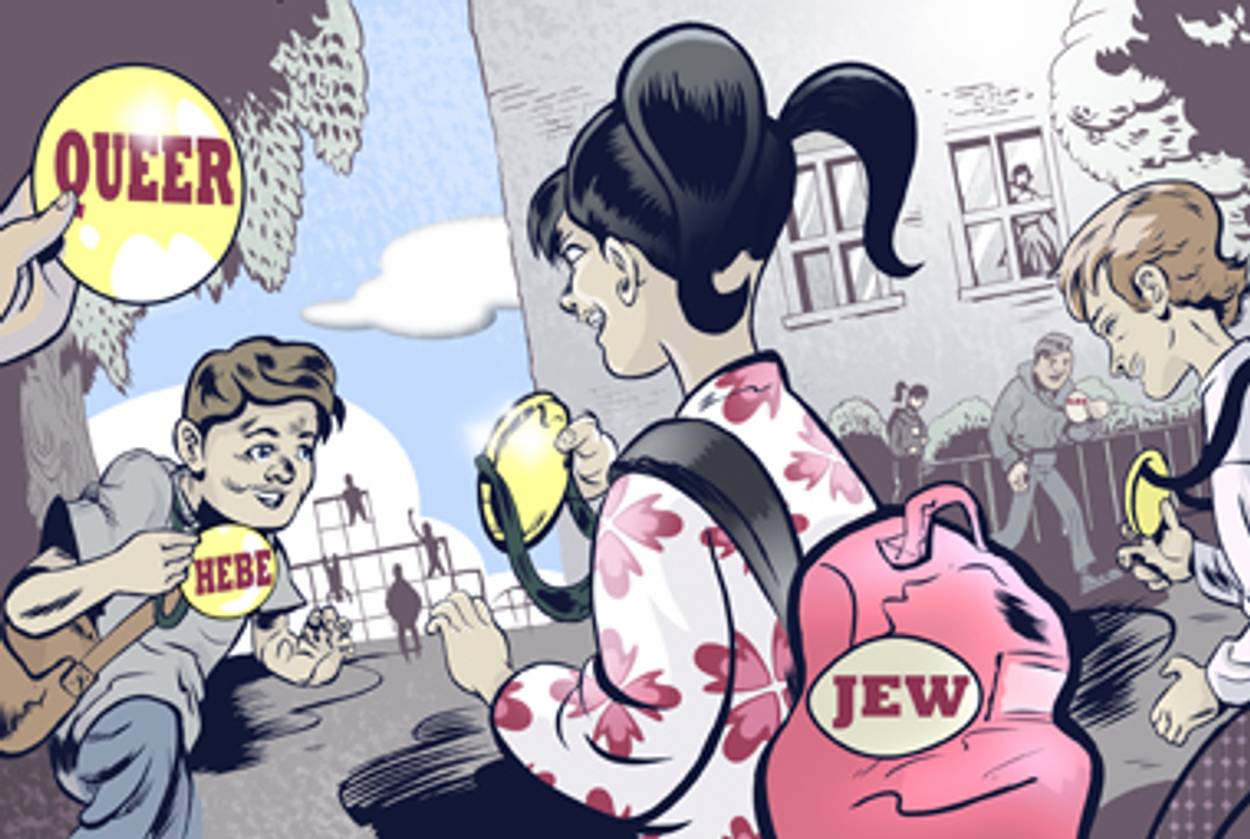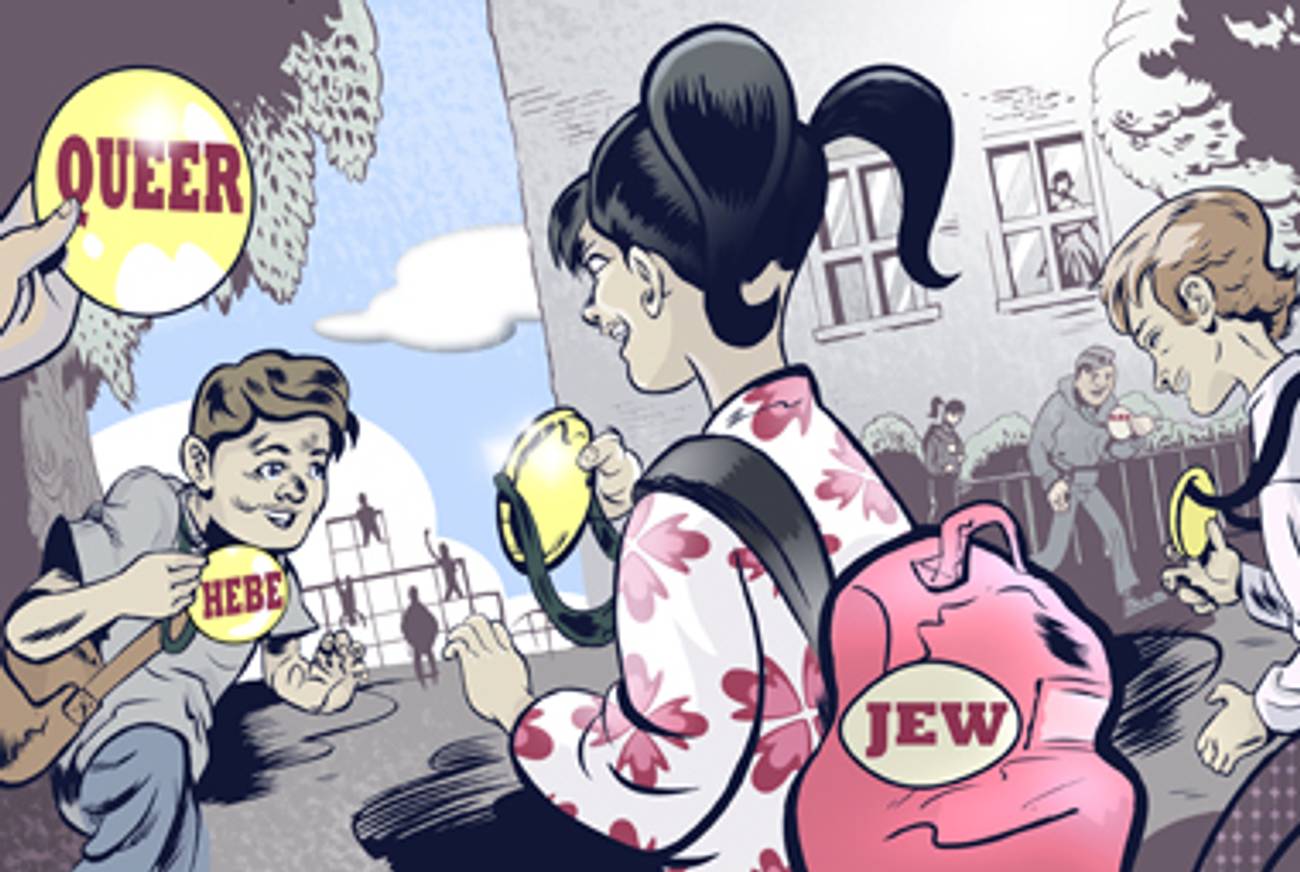Fighting Words
Kids are exposed to many loaded terms each day, from ‘gay’ to ‘Yid’ to the n-word. Some are OK to use, in some contexts, for some people. Some are not. How can we teach them which are which?




Last week was a banner week for the thorniness of language, at least in my world. I wrote about a reality show schmuck teaching my kids the disparaging use of the word “fairy.” (Until that moment, they’d thought fairies had wands and were awesome.) Also last week, a Southern publisher announced it would produce a new edition of The Adventures of Huckleberry Finn in which the word “nigger” is replaced throughout by the word “slave.”
These events are unrelated, yet they have much in common. Thinking about the power of words—and the way the same word can feel embracing or abusive, depending on who’s saying it—made me think about when and how to teach kids about the nuances of terms that may or may not be epithets.
Here’s what I mean: gay, queer, nigga, yid, heeb. All can be used as slurs, but they can also be used as badges of in-group identification.
Josie is 9, and she attends a diverse public school in a diverse neighborhood. She’s heard the n-word used as a term of affection and identity between kids of color. She doesn’t listen to much hip-hop (at home we tend to favor show tunes, old-school punk rock, and Parliament-Funkadelic, thus covering most of the 100 Best Jewish Songs of All Time), but, like most urban kids, she’s certainly going to hear more and more of it as she gets older. And that means I’m going to have to teach her and her little sister that however much you hear the n-word, you don’t get to say it.
And yet I don’t think we should be censoring Mark Twain (or hip-hop artists, or Frederick Douglass, or Ishmael Reed). We should talk to our older kids about historical context, about why the word can be shocking and upsetting. Huck Finn has a specific setting; it’s right and proper to read the book in the frame of reference of the 19th-century South. To change the words is to throw up our hands and refuse to wrestle with our problematic historical past. We abdicate a teachable moment.
Words are complicated. I’ve talked to Josie about the fact that we don’t say “that’s so gay.” (There’s an excellent current public service campaign—my favorite ad is with comedian Wanda Sykes—with the same message.) But it will be a long while before my kids and I have the conversation I had a few years ago with my brother and his husband about the phenomenon of young gay people saying, with edgy irony, “That’s so gay.” When you get to be confident enough about your place in the world, do you get to reclaim that kind of use of language? (My brother thinks maybe. My brother-in-law thinks no.) Is using “gay” in the old-school pejorative way the next evolutionary step after reclaiming “queer”? (That reclamation took a bad word and made it a good word, but the gays who say, “That’s so gay” are using “gay” as a bad word! It makes your head spin.)
And then there’s the problem of Jewish words that swing both ways, like Yid and Hebe. In the Ashkenazi Orthodox world, of course, Yid and Yidden mean simply Jews and Jewish people; the words have a homey, positive gloss. (“Yid equals man plus mitzves,” or good deeds, writes Michael Wex in Born to Kvetch.) But reading back through American Jewish history and literature, you’ll see “yid” used repeatedly by non-Jews as a slur. “Hebe” used to be a verbal slap, too, but now, reborn as “Heeb,” it’s a hipster magazine, a fist-bump among the cool kids of the tribe. Jon Stewart, who I credit with popularizing one of my fave could-go-either-way descriptors, “Jewy,” was there early with “Hebe,” too—in 2000, long before Heeb magazine was pondering calling Joe Lieberman a dickhead (though, of course, that was before Joe Lieberman was a dickhead), Stewart titled a segment about Hillary Clinton’s alleged anti-Semitism “Hebe Said, She Said.”
“Language meaning changes,” says Sarah Bunin Benor, associate professor of contemporary Jewish studies at Hebrew Union College. “Pejoration, in which the meaning of a word gets more negative, and amelioration, in which a word’s meaning becomes more favorable, happen constantly. In Mexico City, there’s a Syrian Jewish community known as shajatos, which comes from the Arabic word for slipper and is a derogatory term; the term is now being reclaimed by young Syrian Jews. There are Shajato Pride Facebook groups.”
Even “Jew” is a loaded word. Sure, there’s the verb—to jew someone down—but the noun, too, is laden with years of history and bias, from Shakespeare to Dickens to, oh, practically everybody. “Chaucer’s Prioress’s Tale says that Satan has his wasps’ nest in the hearts of Jews,” Michael Wex told me in an interview. “There’s ‘The Ballad of Little Sir Hugh’ and sundry Latin and English accounts of the supposed ritual murder of Hugh of Lincoln. And let’s not forget The Merchant of Venice and The Jew of Malta. In the latter of case, trust me, ‘Jew’ did not mean ‘fellow citizen of the Mosaic persuasion.’ ”
Historically, Wex says, “ ‘I went to the Jew,’ would have been understood as ‘I went to the pawnbroker/moneylender.’ Likewise, the idea of the ‘Jew store,’ generally a low-priced dry goods or secondhand store, was widespread for a very long time—I can recall it from the sixties.” The word “Jew” connoted “totally unlike us.” Even today, many of us know non-Jews who go out of their way not to say the word Jew; they carefully say “Jewish person.”
“People who avoid the word Jew,” Benor says, “think of it as a negative word because they know it was used in an ugly way in the past.”
Which brings me back to my own little yidden. How do I teach them about the minefield that is the flexibility of language, with all its layers of history and sediment and love and hate?
“It’s all about context,” says Kiki Schaffer, director of the Parenting, Family, and Early Childhood Center at the 14th Street Y in New York City. “It’s not that an individual word has some magic; it’s that we have to consider how that word is going to land. You can explain to kids that words can land with affection in one context and as a putdown in another context. They can say ‘I’m like you’ or ‘I have more power than you.’ ”
Shaffer says that educating kids on the nuances of language can begin as early as age 3 or 4, when theory of mind sets in. That’s when children start to understand that other people have thoughts, feelings, and desires, and those thoughts, feelings, and desires aren’t always in line with theirs. You can explain multiple perspectives to a 4-year-old—calling people a stupidhead can hurt their feelings—and add more complexity as kids get older.
“You can tell a 9-year-old, ‘You have to be scrupulously careful with language,’ ” Shaffer says. “You could tell a Jewish joke because you’re in the in-group; the joke’s about yourself and your people. But if you joke about a group you’re not part of, even if your intentions are good, you could wind up being hurtful. There are trails of memory involved that you don’t share and don’t necessarily understand.”
Parents of kids in Jewish day schools should be particularly clueful about talking about race. Research shows that insisting “children don’t see color” and not discussing difference with them can actually reinforce racism.
Words are complicated. Should we really expect explaining them to kids to be easy? Choosing to say nothing, though, is no answer at all.
Marjorie Ingall is a columnist for Tablet Magazine, and author of Mamaleh Knows Best: What Jewish Mothers Do to Raise Successful, Creative, Empathetic, Independent Children.
Marjorie Ingall is a former columnist for Tablet, the author of Mamaleh Knows Best, and a frequent contributor to the New York Times Book Review.